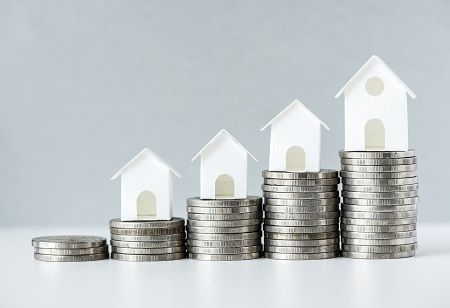
Over the last ten years, the cost of constructing real estate has increased inexorably. The rise has been especially brutal since 2021, for several reasons - inflation, supply chain disruptions, increased demand for infrastructure, global macro-economic events, and evolving government policy.
In five years from 2019 to 2024, the cost of constructing homes went up by about 40 percent. In three years alone, it rose by 27.3 percent - in October 2021, the average cost for Grade A projects in a tier-1 city was approx. Rs. 2,200/sq. ft. By October 2024, it had gone up to approx. Rs. 2,800/sq. ft.
Cost Components:
City-wise Variations in Construction Costs - 2025 (est.) (Rs /sq. ft)
Impact on Property Prices & Developer Strategies
On property buyers - Most developers tend to pass on increased input costs, either in part or completely, to their buyers. Recent data shows that at least 5–6 percent of the total input cost increases are directly reflected in housing prices. In affordable housing, even a hike of Rs. 500–Rs. 800/sq. ft can sharply impact buyer access, since an increase of Rs. 5 lakh is a massive additional burden for price-sensitive buyers when compared to those who buy premium or luxury housing.
On developers' profit margins - Smaller players who develop affordable housing already face thinner margins and are often unable to absorb even small cost increases. Many such developers have slowed down their launches or cut corners on amenities. In contrast, larger developers and luxury segment players can absorb cost increases because they enjoy higher margins and wield higher brand value
Homebuyer agreements: Most builder-buyer agreements include escalation charges, letting developers adjust sale prices upward along with cost increases, especially for under construction projects. This legal flexibility in the absence of regulatory constraints is behind much of the price transmission to buyers.
Housing prices: The combined effect has resulted in residential real estate prices raising by between 9-12 percent annually in recent years, with the increased construction costs a major driver along with rising land costs and reducing inventory. Pricing power remains strongest in metro cities, with less pronounced effects in smaller towns and cities where demand is lower.
Also Read: Tier 2 Cities Shine with Affordable Housing, Easing EMI Burden for Homebuyers
Segment-Specific Trends: Affordable vs. Mid-Range vs. Luxury
Affordable housing - Developers in this segment face the greatest construction cost-related constraints, as their target buyers are extremely price sensitive. Any increase in costs significantly impacts demand and can even result in stalled sales - as is seen in the massive decline in affordable launches share – 40 percent in 2019 to 12 percent in H1 2025, and sales share – 38 percent in 2019 to 18 percent in H1 2025 as per ANAROCK Research data.
Mid-range projects - These projects have some flexibility when it comes to transmitting higher costs to buyers; however, inflation and policy shocks can still edge out a big chunk of buyers in this segment.
Luxury projects - Cost hikes are more easily absorbed by this buyer group, which looks for premium features and tends to have bigger budgets. Price increases are also factored into brand perceptions and the desire for exclusivity. In short, this buyer segment is the least affected by higher input costs.
Tariffs' Potential Impact on Construction Costs - at 25 percent & 50 percent
The key construction materials that are impacted by tariffs are steel, aluminium, cement, equipment, and foreign finishings which are typically sourced from countries like China, US, and Europe. The immediate impact of a 25 percent tariff is that construction costs for projects that depend on imports could rise by 1.5–2.5 percent over current levels, over and above the baseline inflation and market-driven escalation.
However, if a 50 percent tariff is imposed, the scenario turns gloomier. Such a tariff level would potentially push construction costs for the most import-dependent projects up by 5 percent or more. Supply chain disruptions could increase price volatility well beyond the calculations of the tariff itself if retaliatory measures spread globally.
Impacts:
Over the last ten years, the cost of residential real estate construction has gone up in cycles, and this has been made worse recently by global events, inflation, regulatory delays, and now tariffs. The potential of higher tariffs adds even more uncertainty, which might lead to a bigger affordability crisis, delayed launches, and financial strain for both developers and buyers.
Incentives, local sourcing, and regulatory measures are among the government and business actions that can help stabilize costs and housing affordability in the future.
Potential Impact of GST Reforms
The revised GST structuring signalled by the government can make a positive difference to construction costs. It has been proposed that there will only be two key rates of 5 percent and 18 percent, and that GST on cement will be reduced from 28 percent to 18 percent. This would be a major relief as it would decrease the overall tax burden on critical input costs. Developers will have to pay less for cement, steel and other inputs and will also benefit from simplified regulatory compliance.
The GST reforms can deliver bring modest but meaningful reductions in housing prices. For affordable housing, which is currently taxed at 1 percent, the reduction would be limited though lower input costs - especially if input tax credits (ITC) are restored – can lower prices by up to 2–4 percent. In the mid-segment, a GST reduction from 5 percent to 3 percent could cut prices by 2–3 percent. In the luxury homes segment, we could at best expect nuanced changes because while input costs may reduce, the luxury items used in such projects may be subject to the highest 40 percent rate, thus reducing the potential for price reductions.
We use cookies to ensure you get the best experience on our website. Read more...
Copyright © 2025 HomesIndiaMagazine. All Rights Reserved.